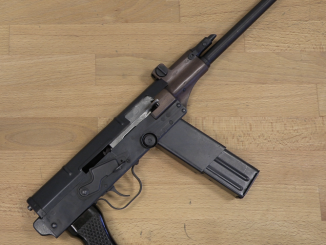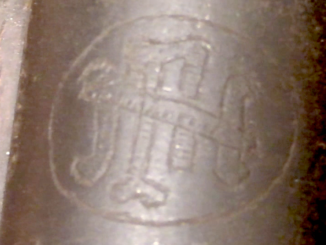This is a copy of the M1 Carbine made in China late in the Chinese civil war – likely between 1945 and 1949. While there was an attempt at factory production of a true M1 Carbine copy in northern China later, this example is actually a bolt action which simply copies the look and handling of the M1 Carbine (and uses M1 Carbine magazines). Unfortunately, I have no way of knowing exactly who made it or where, but we can see fake German markings as are typical of warlord-era pistols.
Related Articles

Submachine Guns
Type 79 SMG: China’s MP7 At Home
The Type 79 is an overly-complex submachine gun that uses a scaled-down AK operating system chambered for 7.62x25mm Tokarev. In many ways, this is akin to the H&K MP7 – it’s a miniaturized combat rifle. […]

Bolt Action Rifles
Vintage Saturday: Mr. Lee Goes to China
Note the bandoliers of individual cartridges – these Lee-Metfords predate the adoption of charger clips, and would have been reloading one round at a time.

Bolt Action Rifles
Chinese Mystery Mauser: Fake FN Model 30
“Arming the Dragon” by Dolf Goldsmith is now available and shipping! One of the most common rifles in Warlord-era China was the Mauser Model 98 short rifle. Various Chinese armies bought large numbers of them […]

“(…)has to be post-World War Two(…)because that’s when M1 carbines
would have been in China.(…)”
M1 Carbine did appeared in said place during World War II, as according to https://wiki2.org/en/List_of_Chinese_military_equipment_in_World_War_II
.30 Carbine Milton E. Miles of SACO considered the light-weight M1 Carbine to be more suitable to the Chinese soldiers than the bigger Mauser rifles, therefore, most SACO units from 1943 on were issued with this semi-automatic weapon.
“(…)is patterned off of the Gewehr 88(…)”
This is quite surprising for me, as I would except repeating version of M1 Carbine would be straight-pull (mechanically: M1 Carbine sans gas system). Anyway there is also known single-shot, lets’ call it look-a-like, of said weapon https://collection.nam.ac.uk/detail.php?acc=1965-03-48-1
I’m not so sure it’s either Chinese or dates to the 1940s.
See Improvised Modified Firearms (2nd ed) by J.David Truby and John Minnery (Paladin Press, 1979) (free online at archive.org)
https://archive.org/details/improvisedmodifi0000trub
In the chapter on the Vietnam War, bottom of P. 126, they show a Viet Cong manufactured M1 Carbine copy. They state that such “home made” Carbines, in both self-loading (usually straight-blowback) and more often bolt-action form, were common in the early years of American involvement due to their use by French forces during the earlier Indochina campaigns. The Carbine was also a favorite weapon of ARVN units, especially rangers.
The bolt action looks less Mauser 1898 than Mosin-Nagant 1891 to me. Note the split receiver bridge and the bolt handle acting as an extra “safety lug”, both typical of the 1891 system. Basically, this is a Mosin action “scaled down” to fit the .30 USC round.
As to the inscription, such “word salad” inscriptions were typical of guns made in the Cao Dai region. T & M show a Cao Dai-made M1911A1 copy, in 7.62 x 25mm, with the slide inscription “PITTSBURG MADE IN USA”. They suspected it was reference to the Union Switch & Signal Co., which of course made M1911A1 .45 automatics during WW2. Such inscriptions were added, by hand engraving, mainly for looks.
So, probably Vietnamese, 1950s to early 1960s. Just a SWAG.
clear ether
eon
“(…)probably Vietnamese(…)”
If it is so, then that would explain (rust-free) brass butt-plate, as Vietnam is totally in monsoon area, though PRC is partially in that area, so similar reasoning could be made by someone working in southern part thereof.
is this the famous WAUSER M-1 carbine?
This is actually a pretty darn good gun, and the woodwork is very decent as well.
The woodwork makes me wonder if a real M1 Carbine stock and magazine was obtained and the hacked together hardware added.
Going back to IMF, most such copies start with an “authentic” barrel, which is the most difficult part to make from scratch. (Rifling is harder than it looks.)
The next most difficult thing to make? A box magazine. So again, “authentic” parts are preferred.
Once those components are available, everything else, bolts, actions, and etc. can be made by hand. Yes, even coil springs.
A wood stock is easily made. By sawing to shape, carving, sanding, finishing, and in this case likely polishing.
For some data on how it’s done, see
Philippine Underground Workshop Submachine Guns- J.M. Ramos
http://archive.smallarmsreview.com/display.article.cfm?idarticles=1789
There is a long tradition of this in the Philippines and throughout Southeast Asia.
clear ether
eon
Another point is that every single damaged weapon that goes into one of these impromptu workshops can be salvaged, and an ungodly number of “just good enough” working weapons can be made from them.
Somewhere out there is a training package that they made back during the Vietnam War era, and it goes over in nauseating detail just how many improvised weapons can be put together from the detritus of battle. It was pretty damn impressive, when you considered the state of what was abandoned, and then what they made out of it.
I mean, you consider it… Say you leave behind a couple of broken M1 carbines with bandoliers of magazines. Get those to a decent facility and some good craftsmen? You’ve now got magazines (one of the harder parts of a modern weapon to fabricate, believe it or not…) enough for a half-dozen improvised rifles, and you can re-purpose those burnt-out MG barrels as rifle barrels while someone is filing and fitting receivers… Have a couple of kids making stocks out of tropical hardwoods, and you’re way ahead of just making zip guns.
The VC and NVA were stealing machine tools off the docks in South Vietnam, getting them out into the jungle workshops, and turning out some really impressive stuff. The presentation I’m talking about showed what they’d found in one of the workshops they’d managed to overrun during the Laotian incursion, and it was something else.
Before I started trying to pronounce on the provenance of this gun that Ian has found, I’d want to know a lot more about the context it was found in, and what year it appeared. The marking suggest Chinese, but… I dunno. I’ve seen something similar written up in the Vietnamese War files I once dug through.
Back before Israeli independence, the Haganah had literally underground workshops at various kibbutzes making Sten guns.
Their primary resource? British scrap piles of rusted-out or otherwise redlined SMLEs.
One shot-out 0.303in barrel could be cut in two, reamed out to 0.355in, rifled and chambered to make two Sten MK II barrels.
During the war, the Danish resistance similarly made Sten MK IIs literally right under the noses of the occupying Wehrmacht.
Let’s not even get into the whole Darra Adam Khel region.
As John Minnery once said, to deprive people of small arms, you pretty much have to take away everything down to and including indoor plumbing.
cheers
eon
The gun control idjits are delusional magical thinkers; their conception of the world is that were we just to rid it of weapons, we’d all sit in circles around campfires and sing kumbayah incessantly. Which would likely drive enough of us into madness that there would be a net gain in terms of violence perpetrated with bare hands.
The real issue is that the idjit class is uncomfortable with the idea of human agency. They can’t accept that humans are basically bastards and bear considerable watching due to general slyness and cunning of the population. Because they can’t accept this fact, they have to blame some outside agency, like talking guns. I’ve no doubt that many of this ilk blamed rocks, back in the day.
What they don’t get is that even if they managed to pad every hard surface in the world, there will still be people getting killed because other people decided to suffocate them in all the pretty pink pillows…
I have few illusions about the perfection of man; knowing the rest of you sorry bastards the way I do, I’ll remain over here, minding my own business. Heavily armed, and watching you…
Specific humans are trustworthy; humanity in general is absolutely not.
I found a good channel from, I think Syria, where they repair and refurbish AKs in a really bad state (like receiver broken in 2 and mangled, like it was run over with a tank in desert sand), need to search for a link since its arabian name and characters.
Found it:
https://www.youtube.com/watch?v=NYHfnvvzFuI
what really cracked me up laughing on the channel, is seeing a video of lion (female) poking its head through concrete block high up on building, in the middle of the night. I think its a local pet of someone
Ian — are you sure the example you are showing was built from scratch and not cobbled together from multiple existing pieces?
Not a bad idea for modern commercial civilian sale, actually, as plinker, scout gun or light game rifle, if the locking system is strong enough. Certain to be more reliable than an original M1 carbine! There must be some amortized machinery for cheaply making bolts and receivers lying around out there …
My “dream gun” along those lines would be a small-ring Mauser with an 18″ or so barrel in 7.62 x 39mm.
Or else the no-longer-made Ruger 96 lever action in the same caliber.
cheers
eon
“(…)small-ring Mauser with an 18″ or so barrel in 7.62 x 39mm.(…)”
I do not know if it count as “small” but rest sounds like CZ 527 https://www.luckygunner.com/lounge/cz-527-carbine-review/
I would be very tempted, as long as the price was right.
A Far East Jeff Cooper on a small budget, indefatigably pimping his “scout rifle concept”?
Hey Ian,
We have a bolt action M1 Carbine made by Abe Seiderman at our auction house along with several other experimental rifles that Seiderman built from his personal collection. If you would like to see them or film them before March please contact us!-RL LSBauctions.
I appreciate the offer, but I’m going to be on the road until March.